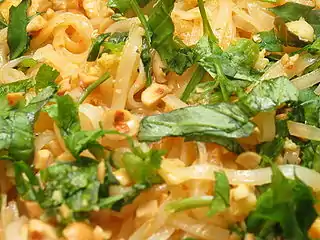Rice noodles
Rice noodles, or simply rice noodle, are noodles made from rice. The principal ingredients are rice flour and water. Sometimes ingredients such as tapioca or corn starch are added in order to improve the transparency or increase the gelatinous and chewy texture of the noodles. Rice noodles are most common in the cuisines of East, Southeast Asia and South Asia. They are available fresh, frozen, or dried, in various shapes, thicknesses and textures. Fresh noodles are also highly perishable; their shelf life may be just several days.
| Look up rice noodle in Wiktionary, the free dictionary. |
 Thin rice noodles in dried form | |
| Type | Noodle |
|---|---|
| Place of origin | China |
| Region or state | East Asia, Indian subcontinent and Southeast Asia |
| Main ingredients | Rice flour, water |
| Variations | Mí fěn, Shāhé fěn, Mi xian, Bánh canh, Bánh phở, Idiyappam, Sevai, Khanom chin |

History
The origin of rice noodles dates back to China during the Qin dynasty when people from northern China invaded the south. Due to climatic conditions, the northern Chinese have traditionally preferred wheat and millet which grew in cold weather while the southern Chinese preferred rice which grew in hot weather. Noodles are traditionally made out of wheat and eaten throughout northern China so to adapt, northern cooks tried to prepare "noodles" using rice, thus inventing rice noodles. Over time rice noodles and their processing methods have been introduced around the world, becoming especially popular in Southeast Asia.[1]
The shelf life may be extended by drying and removing its moisture content. Studies of drying rice noodles were conducted by the International Food Research Journal.[2]
Varieties
- Mí fĕn (米粉, rice vermicelli, also known by many other names in a number of Asian countries)
- Hé fĕn (河粉, also called ho fun)
- Mí xiàn (米线, from Yunnan Province)
- Bánh canh
- Bánh phở
- Idiyappam (இடியாப்பம்)
- Sevai (சேவை|சேவை/சந்தகை/சேமியா)
- Khanom chin (Thai: ขนมจีน)
- Kuān tiáo (宽条, or 宽粉)
In Tamil Nadu and parts of Kerala, Sri Lanka, Laos, Singapore, and Malaysia, a type of rice noodle known as idiyappam is usually made fresh at home and tends to be tender with a distinctive texture. A variation of idiappam, known as sevai in Tamil Nadu, is used as the base in savoury preparations; it is also called santhakai in the Coimbatore region of Tamil Nadu. A similar preparation, shyavige, is popular in Karnataka. Pasta made from brown rice flour is also available (in health food stores in Western nations) as an alternative to wheat flour-based noodles for individuals who are allergic to wheat or gluten.
Dishes made from rice noodles


Cambodian
Burmese
- Mohinga
- A-thoke-sone
- Rakhine Kyarzan thoke
- Nan gyi thohk
- Shan Khaukswe ( Similar to Yunnan Mi Xian )
- Mee Shay
- Baik Kut kyee Kaik
Filipino
- Sinanta
- Pancit Bihon
- Pancit Luglug
- Pancit Palabok
- Pancit Malabon
- Pancit Miki-Bihon
- Mami Bihon
Indonesia
- Bihun
- Kwetiau Medan
- Kwetiau goreng
- Kwetiau kuah
Lao
- Khao poon
- Khao soi
- Khao piak sen
- khua mee
- Feu or Fer
Malaysian
Thai
- Pad Thai
- Kuai tiao - Thai Noodle
- Khao soi
- Mi krop
- Nam ngiao
- Kuai tiao nam tok - Thai Noodle soup darkened with raw blood
- Phat si-io - Thai Stir Fried Noodles in Dark Soy Sauce
- Rat na - Thai Gravy Noodles
- Phat khi mao
- Kuai tiao khua kai
Vietnamese
- Bánh cuốn - sheet of rice flour filled with spiced minced pork and mushroom
- Bánh hỏi
- Bún bò Huế - rice vermicelli in soup with beef, lemon grass and other ingredients
- Bún riêu - rice vermicelli in soup with crab meat
- Mì Quảng
- Phở
- Summer roll
See also
References
- Liu, Y.L. (2010). Processing technology of rice and its products. China: China Light Industry Press. pp. 84–85.
- Ismail, M.H. "Transparency phenomena of flat-rice noodles (kuew teow) at drying at soaking variation" (PDF). www.ifrj.upm.edu.my. Retrieved 26 June 2018.